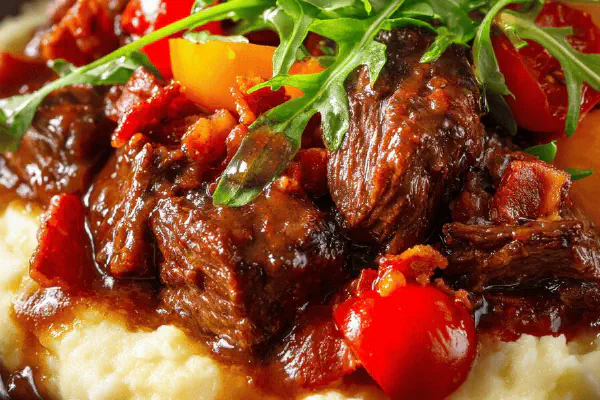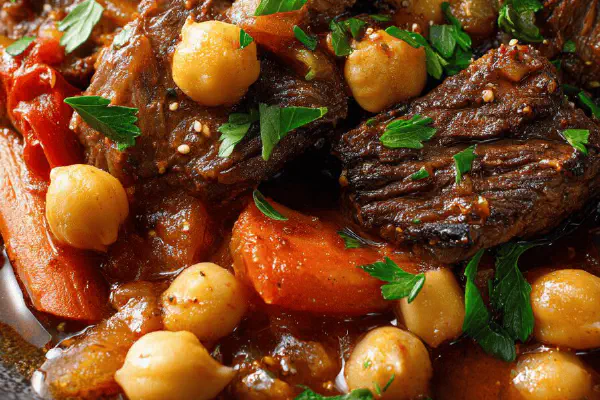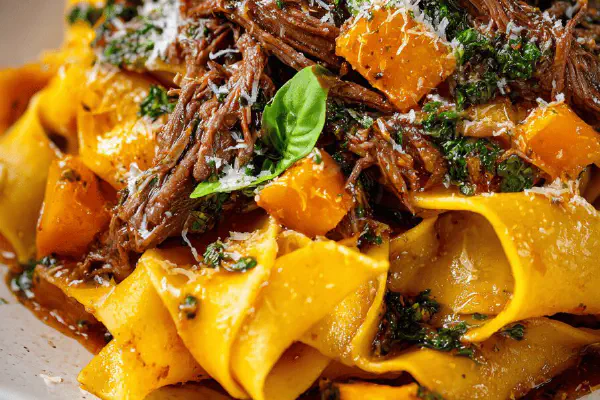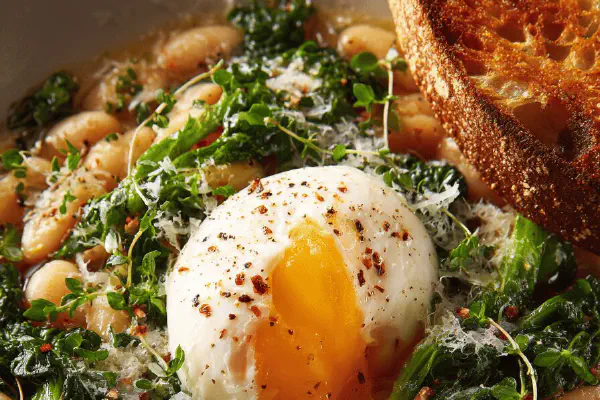Beef Beet Ragout Penne
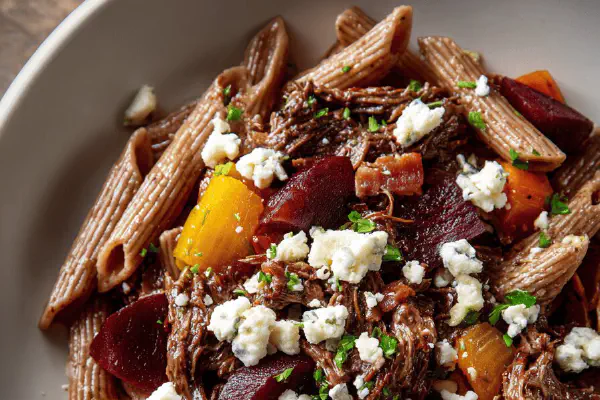
By Emma
Certified Culinary Professional
Ingredients
- 500 g beef chuck roast, trimmed and cut into chunks
- 25 ml olive oil
- 2 small onions, finely chopped
- 3 cloves garlic, minced
- 10 ml fresh thyme leaves
- 450 ml dry red wine
- 900 ml beef stock
- 2 large beets, peeled and cubed
- 8 thin slices pancetta
- 400 g whole wheat penne
- 120 g creamy gorgonzola cheese, crumbled
- 1 bay leaf
- fresh cracked black pepper
- salt
About the ingredients
Method
- Set oven rack to middle. Preheat oven to 160 °C (325 °F).
- Heat half oil in heavy ovenproof pot over medium-high. Brown half beef chunks until deep seared crust forms, 3-4 minutes per batch. Salt and pepper generously. Transfer meat to plate. Repeat with rest.
- Lower heat to medium. Add onions and garlic to fat. Stir until onions turn glossy and translucent, roughly 6 minutes. Add thyme and bay leaf. Pour in red wine; scrape browned bits from bottom. Let wine reduce by half, thickens glossy, about 8 minutes.
- Return beef to pot. Pour in beef stock and add cubed beets. Bring mixture just to boil. Cover and transfer to oven.
- Cook for about 2 hrs 40 minutes. Check beef tenderness at 2 hrs 30 mins; meat should be fork-tender, beets soft but hold shape.
- Increase oven temp to 200 °C (400 °F). Line baking sheet with parchment paper.
- Spread pancetta slices single layer on sheet. Roast 10 minutes until crisp but not burnt. Remove; drain on paper towels.
- Meanwhile, cook penne in large pot salted boiling water. Follow packet al dente timing, usually 6-8 minutes for whole wheat. Scoop out 150 ml pasta water before draining.
- Remove bay leaf from ragout; discard. Fold penne into ragout gently. Add pasta water gradually, stirring, to loosen sauce if too thick. Adjust salt and pepper. Sauce should cling but not drown pasta.
- Serve in warm shallow bowls. Scatter pancetta shards and crumble blue cheese on top. Cheese melts slightly from pasta heat. Dabble with extra pepper if desired.
Cooking tips
Chef's notes
- 💡 Brown beef chunks dry, no crowding pot, hear subtle sizzling edge. Forms deep crust, layers umami. Use medium-high so a crust forms not stew. Slice uniformly chunks help even cooking; thicker crust means slower internal heat. Salt right before searing; seasoning crust pulls aroma. Repeat in batches, hold on plate keeps juices.
- 💡 Wine reduction vital take time; bubbles slow to glossy, thick, almost clingy stir to scrape fond. Smell changes from sharp alcohol to fruity notes; don’t rush or sauce stays thin. If too sharp add pinch sugar or carrot chunks to mellow. If no wine, beet juice plus splash balsamic gives acidity, color echo.
- 💡 Beets must hold shape, not mush fragile; peel and cube evenly. Add late in braise; too early dissolves texture. Check doneness visually; bright color soft but firm. Overcooked collapses, taste flat. For vegan twist, swap beef for mushrooms, omit pancetta and cheese, add smoked paprika for depth.
- 💡 Pancetta roasting slow 200 °C crisp without burning. Watch last 2 minutes closely; curls, color shift from pale pink to ruby tells done. Remove early if edges turn dark brown; bitterness follows quickly. Drain excess fat well; prevents greasy mouthfeel, keeps contrast texture intact.
- 💡 Pasta timing key, al dente firm bite. Reserve pasta water, full of starch helps loosen sauce without thinning flavor. Add gradually, stir gently folding penne to ragout. Avoid breaking beets or meat chunks; keep texture contrast. Season at end salt and cracked pepper, pancetta and blue cheese add saltiness naturally.
Common questions
How to know when beef is done?
Fork tender test mostly. Should flake but not fall apart. Visual checks too; juices clear, crust darkened. Texture buttery, not chewy. Takes time. Oven temp important, lower slow heat breaks connective tissue.
What if sauce too thin?
Simmer longer without lid or thicken starch water. Deglaze with splash sherry or brandy before adding liquids gives flavor boost. Reduce wine more upfront. Thicken with roux rare, starch from pasta water better keeps texture.
Can I replace beef stock?
Chicken stock less rich but works in pinch. Mushroom broth great vegan option. Water+herbs if desperate but flavor dulls fast. Adjust salt last; stock adds saltiness so taste frequently. Homemade stock best if you got time.
How to store leftovers?
Cool quickly; fridge 2-3 days fine. Reheat gently low temp avoid drying beef. Sauce thickens redistribute pasta water if dry. Freeze in sealed container up to 3 months. Thaw overnight fridge, stir before warming.
